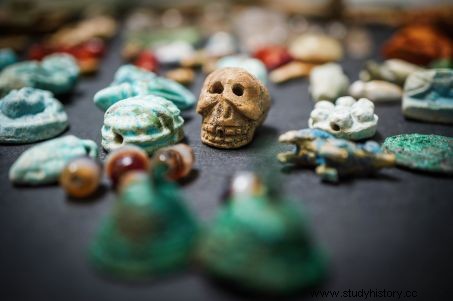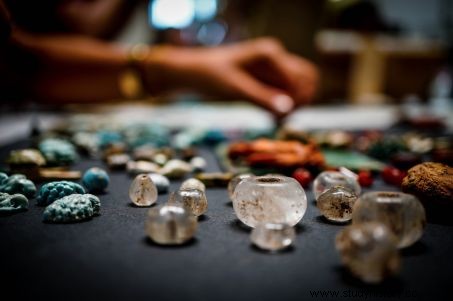After 2000 years spent in the soil of the ancient city, talismans and lucky charms were found in a box in Pompeii.

Gems, amulets, and other talismans found in a box exhumed in the House of the Garden, on the site of Pompeii (Italy).
The gri-gris weren't enough to save them! Phallic amulets, magic gems, delicate scarabs in blue earthenware, creations in bronze, bone or amber, glass pastes representing Dyonisos, or a dancing satyr... All these objects are among the protective talismans recently put day in one of the domus unobstructed by the archaeologists at work in Regio V, the new study area of the Pompeii site (Italy). "These jewels and small objects related to the feminine universe of the time were found in one of the rooms of the Casa dei Jiardino, (the garden house)" , says the Archaeological Soprintendenza of Pompeii. Collected in a wooden box by the curators of the Laboratory for the Restoration of the Archaeological Park of the ancient city of Campania, the precious treasure could not have been taken away by the occupants of the household... found dead, engulfed by the catastrophic eruption of Vesuvius, in 79 AD.

Egyptian scarabs in blue faience, bone skull... some of the talismans kept in the Garden House box. (© Cesare Abbate/ Ansa)
Indeed, still according to the Soprintendenza, ten victims - women and children - were also exhumed in one of the rooms of the house. The men had apparently left, the bodies of two of them having been found a few meters from the front door. The team of specialists of the great Pompeii project is working to shed light on the composition of this family, in an attempt to reconstruct its history:"We are trying to establish the family ties and to reconstruct the biography of this family group based on DNA analysis" . The absence of gold jewels, as the elegant women of Pompeii liked to wear, which would have been present in the jewelry box of a young woman, even of average wealth, seems to tell another story. For Massimo Ossana, General Director of the Pompeii Archaeological Park:"These talismans found are those to which the power to ward off bad luck was attributed" .

In antiquity, certain gems had apotropaic properties, intended to ward off misfortune. (© Cesare Abbate / Ansa)
In Antiquity, these so-called "apotropaic" productions were intended to ward off evil influences, supposed to protect their wearer against bad luck and misfortune... Facing Vesuvius, and on this land of Campania which did not fail to tremble regularly, the The use of magic was undoubtedly very popular... Especially since in the Roman world, this type of object also had to do with fertility, seduction, happiness, the smooth running of a birth or the success of a a marriage.
"These everyday objects are extraordinary because they tell micro-stories"
The studies carried out in the Casa dei Giardino are still in their infancy. Cleaned and restored, the lucky charms that make up this moving treasure will now be subjected to a more detailed study. "These everyday objects are extraordinary because they tell micro-stories, biographies of city residents who tried to escape the eruption" , Massimo Osanna, who plans to present these relics in an upcoming exhibition, told the Ansa news agency. Discoveries that continue to be a source of wonder. Especially since the domus may not have given up all its secrets. It was already on its walls that archaeologists had discovered a few months ago, an inscription that led to the modification of the date of the eruption of Vesuvius, changed from August 24 to October 24, 79.
